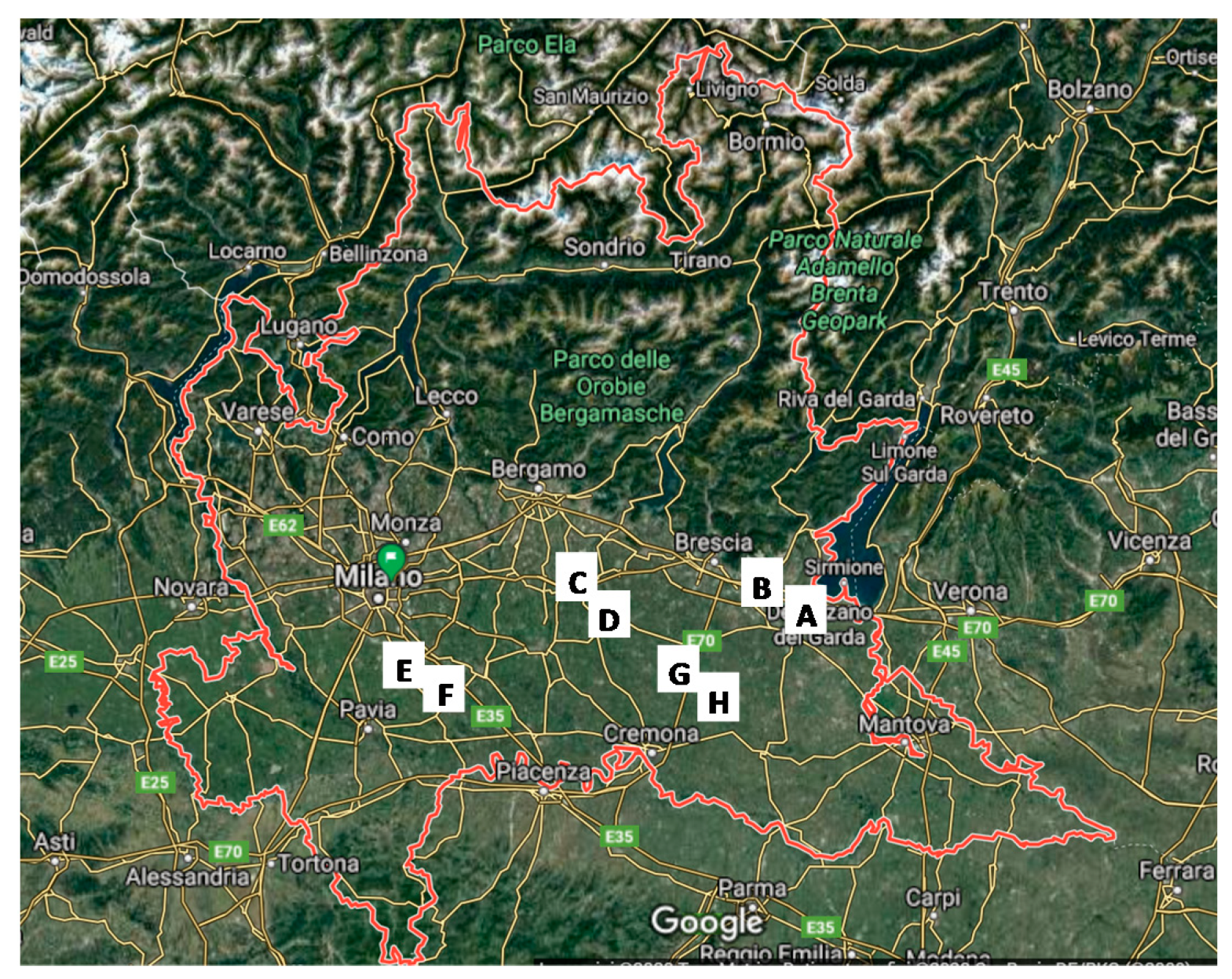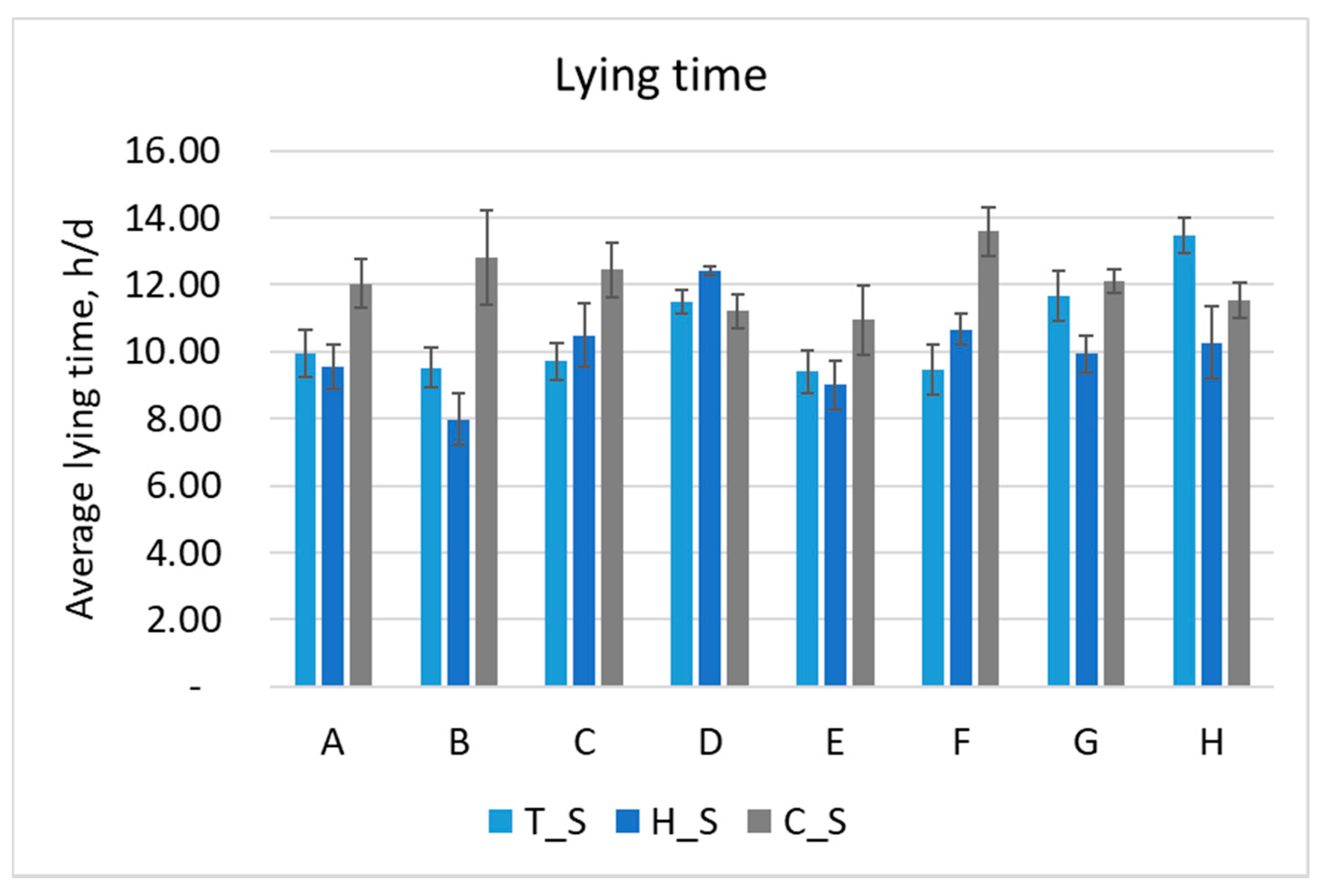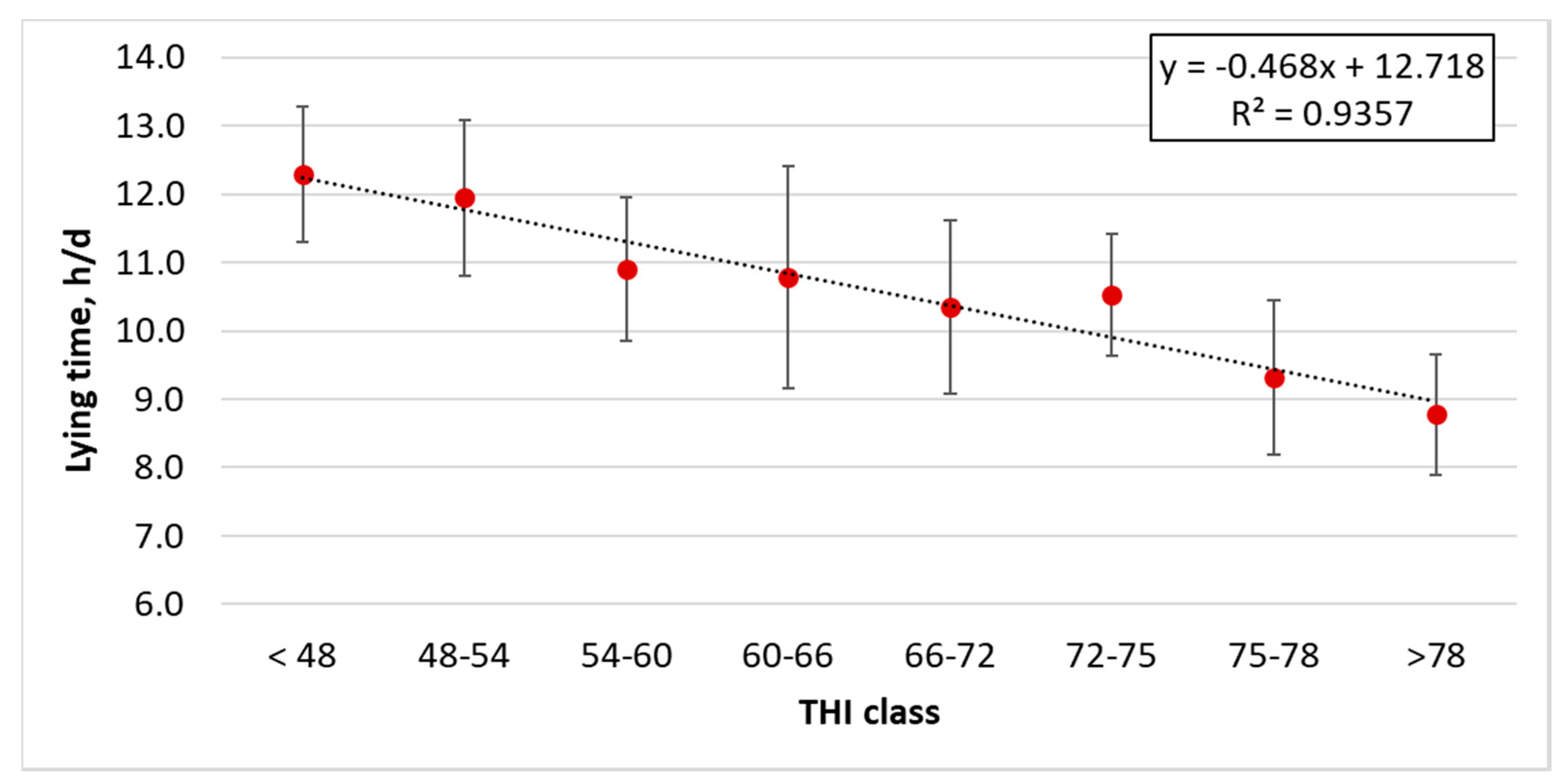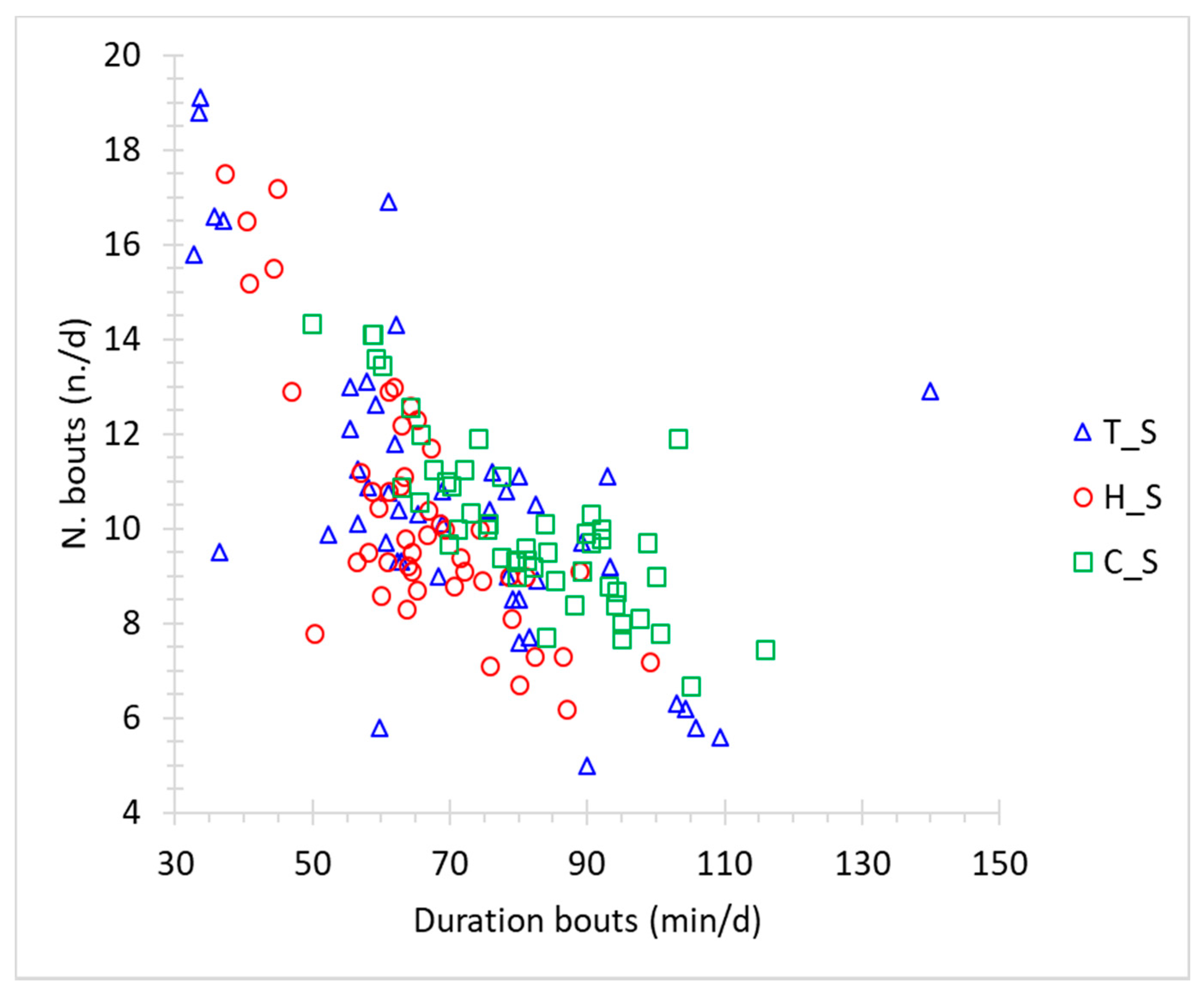A Survey of Dairy Cattle Behavior in Different Barns in Northern Italy
Simple Summary
Abstract
1. Introduction
2. Materials and Methods
2.1. Livestock Farms
2.2. Climatic Variables
2.3. Monitoring of Cows’ Behavior
3. Results
3.1. Results Per Period
3.2. Environmental Results Per Farm
3.3. Behavioral Results Per Farm
3.4. Relations Between Environmental and Behavioral Aspects
4. Discussion
5. Conclusions
Author Contributions
Funding
Acknowledgments
Conflicts of Interest
References
- Brown-Brandl, T.M.; Eigenberg, R.A.; Nienaber, J.A.; Hahn, G.L. Dynamic response indicators of heat stress in shaded and non-shaded feedlot cattle, part 1: Analysis of indicators. Biosyst. Eng. 2005, 90, 451–462. [Google Scholar] [CrossRef]
- Gernand, E.; König, S.; Kipp, C. Influence of on-farm measurements for heat stress indicators on dairy cow productivity, female fertility, and health. J. Dairy Sci. 2019, 102, 6660–6671. [Google Scholar] [CrossRef]
- Da Rosa Righi, R.; Goldschmidt, G.; Kunst, R.; Deon, C.; da Costa, C.A. Towards combining data prediction and internet of things to manage milk production on dairy cows. Comput. Electron. Agric. 2020, 169, 105156. [Google Scholar] [CrossRef]
- Nienaber, J.A.; Hahn, G.L. Livestock production system management responses to thermal challenges. Int. J. Biometeorol. 2007, 52, 149–157. [Google Scholar] [CrossRef]
- Wathes, C.M.; Kristensen, H.H.; Aerts, J.M.; Berckmans, D. Is precision livestock farming an engineer’s daydream or nightmare, an animal’s friend or foe, and a farmer’s panacea or pitfall? Comput. Electron. Agric. 2008, 64, 2–10. [Google Scholar] [CrossRef]
- Tao, S.; Orellana Rivas, R.M.; Marins, T.N.; Chen, Y.-C.; Gao, J.; Bernard, J.K. Impact of heat stress on lactational performance of dairy cows. Theriogenology 2020. [Google Scholar] [CrossRef]
- Mayo, L.M.; Silvia, W.J.; Ray, D.L.; Jones, B.W.; Stone, A.E.; Tsai, I.C.; Heersche, G. Automated estrous detection using multiple commercial precision dairy monitoring technologies in synchronized dairy cows. J. Dairy Sci. 2019, 102, 2645–2656. [Google Scholar] [CrossRef]
- Potter, T.L.; Arndt, C.; Hristov, A.N. Short communication: Increased somatic cell count is associated with milk loss and reduced feed efficiency in lactating dairy cows. J. Dairy Sci. 2018, 101, 9510–9515. [Google Scholar] [CrossRef]
- Brandt, P.; Kvakić, M.; Butterbach-Bahl, K.; Rufino, M.C. How to target climate-smart agriculture? Concept and application of the consensus-driven decision support framework “target CSA”. Agric. Syst. 2017, 151, 234–245. [Google Scholar] [CrossRef]
- Cammarano, D.; Hawes, C.; Squire, G.; Holland, J.; Rivington, M.; Murgia, T.; Ronga, D. Rainfall and temperature impacts on barley (Hordeum vulgare L.) yield and malting quality in Scotland. Field Crop. Res. 2019, 241, 107559. [Google Scholar] [CrossRef]
- Schütz, K.E.; Rogers, A.R.; Cox, N.R.; Tucker, C.B. Dairy cows prefer shade that offers greater protection against solar radiation in summer: Shade use, behavior, and body temperature. Appl. Anim. Behav. Sci. 2009, 116, 28–34. [Google Scholar] [CrossRef]
- Bar, D.; Kaim, M.; Flamenbaum, I.; Hanochi, B.; Toaff-Rosenstein, R.L. Technical note: Accelerometer-based recording of heavy breathing in lactating and dry cows as an automated measure of heat load. J. Dairy Sci. 2019, 102, 3480–3486. [Google Scholar] [CrossRef] [PubMed]
- ISTAT. National Institute of Statistics. Available online: http://dati.istat.it/# (accessed on 28 February 2020).
- Penati, C.; Tamburini, A.; Timini, M.; Sandrucci, A. Milk production, feeding systems and environmental impact of dairy cattle farming in alpine areas: Results of a field study. Ital. J. Anim. Sci. 2009, 8, 316–318. [Google Scholar] [CrossRef]
- Smit, L.A.M.; Heederik, D. Impacts of intensive livestock production on human health in densely populated regions. GeoHealth 2017, 1, 272–277. [Google Scholar] [CrossRef]
- IPCC. Guidelines for National Greenhouse Gas Inventories. Volume 4: Agriculture, Forestry and Other Land Use. Chapter 1: Introduction; IPCC: Geneva, Switzerland, 2006. [Google Scholar]
- Borgonovo, F.; Conti, C.; Lovarelli, D.; Ferrante, V.; Guarino, M. Improving the sustainability of dairy slurry by a commercial additive treatment. Sustainability 2019, 11, 4998. [Google Scholar] [CrossRef]
- Hou, Y.; Velthof, G.L.; Oenema, O. Mitigation of ammonia, nitrous oxide and methane emissions from manure management chains: A meta-analysis and integrated assessment. Glob. Chang. Biol. 2015, 21, 1293–1312. [Google Scholar] [CrossRef]
- Provolo, G.; Mattachini, G.; Finzi, A.; Cattaneo, M.; Guido, V.; Riva, E. Global warming and acidification potential assessment of a collective manure management system for bioenergy production and nitrogen removal in Northern Italy. Sustainability 2018, 10, 3653. [Google Scholar] [CrossRef]
- Bacenetti, J.; Bava, L.; Zucali, M.; Lovarelli, D.; Sandrucci, A.; Tamburini, A.; Fiala, M. Anaerobic digestion and milking frequency as mitigation strategies of the environmental burden in the milk production systems. Sci. Total Environ. 2016, 539, 450–459. [Google Scholar] [CrossRef]
- Finzi, A.; Riva, E.; Bicoku, A.; Guido, V.; Shallari, S.; Provolo, G. Comparison of techniques for ammonia emission mitigation during storage of livestock manure and assessment of their effect in the management chain. J. Agric. Eng. 2019, 50, 12–19. [Google Scholar] [CrossRef]
- Lovarelli, D.; Falcone, G.; Orsi, L.; Bacenetti, J. Agricultural small anaerobic digestion plants: Combining economic and environmental assessment. Biomass Bioenerg. 2019, 128, 105302. [Google Scholar] [CrossRef]
- Fournel, S.; Rousseau, A.N.; Laberge, B. Rethinking environment control strategy of confined animal housing systems through precision livestock farming. Biosyst. Eng. 2017, 155, 96–123. [Google Scholar] [CrossRef]
- Berckmans, D.; Guarino, M. From the Editors: Precision livestock farming for the global livestock sector. Anim. Front. 2017, 7, 4–5. [Google Scholar] [CrossRef]
- Grinter, L.N.; Campler, M.R.; Costa, J.H.C. Technical note: Validation of a behavior-monitoring collar’s precision and accuracy to measure rumination, feeding, and resting time of lactating dairy cows. J. Dairy Sci. 2019, 102, 3487–3494. [Google Scholar] [CrossRef] [PubMed]
- Berckmans, D. General introduction to precision livestock farming. Anim. Front. 2017, 7, 6–11. [Google Scholar] [CrossRef]
- Brown-Brandl, T.M.; Adrion, F.; Maselyne, J.; Kapun, A.; Hessel, E.F.; Saeys, W.; Van Nuffel, A.; Gallmann, E. A review of passive radio frequency identification systems for animal monitoring in livestock facilities. Appl. Eng. Agric. 2019, 35, 579–591. [Google Scholar] [CrossRef]
- Provolo, G.; Riva, E. Influence of Temperature and Humidity on Dairy Cow Behaviour in Freestall Barns. 2008. In Agricultural and Biosystems Engineering for a Sustainable World, Proceedings of the International Conference Agricultural Engineering, Hersonissos, Crete, Greece, 23–25 June 2008; EurAgEng: Schaerbeek, Belgium, 2008. [Google Scholar]
- Mattachini, G.; Riva, E.; Bisaglia, C.; Pompe, J.C.A.M.; Provolo, G. Methodology for quantifying the behavioral activity of dairy cows in freestall barns. J. Anim. Sci. 2013, 91, 4899–4907. [Google Scholar] [CrossRef]
- ASABE. Design of Ventilation Systems for Poultry and Livestock Shelters. In Standards American Society of 2006, Agricultural and Biological Engineers, 53rd ed.; ASABE: St. Joseph, MI, USA, 2006; pp. 652–670. [Google Scholar]
- ARPA. Regional Agency for the Protection of the Environment. Available online: https://www.arpalombardia.it/Pages/ARPA_Home_Page.aspx. (accessed on 28 February 2020).
- Arcidiacono, C.; Porto, S.M.C.; Mancino, M.; Cascone, G. A software tool for the automatic and real-time analysis of cow velocity data in free-stall barns: The case study of oestrus detection from Ultra-Wide-Band data. Biosyst. Eng. 2018, 173, 157–165. [Google Scholar] [CrossRef]
- Mattachini, G.; Pompe, J.; Finzi, A.; Tullo, E.; Riva, E.; Provolo, G. Effects of feeding frequency on the lying behavior of dairy cows in a loose housing with automatic feeding and milking system. Animals 2019, 9, 121. [Google Scholar] [CrossRef] [PubMed]
- Hindermann, P.; Nüesch, S.; Früh, D.; Rüst, A.; Gygax, L. High precision real-time location estimates in a real-life barn environment using a commercial ultra wideband chip. Comput. Electron. Agric. 2020, 170, 105250. [Google Scholar] [CrossRef]
- Tullo, E.; Mattachini, G.; Riva, E.; Finzi, A.; Provolo, G.; Guarino, M. Effects of climatic conditions on the lying behavior of a group of primiparous dairy cows. Animals 2019, 9, 869. [Google Scholar] [CrossRef] [PubMed]
- Damasceno, F.A.; Oliveira, C.E.A.; Ferraz, G.A.S.; Nascimento, J.A.C.; Barbari, M.; Ferraz, P.F.P. Spatial distribution of thermal variables, acoustics and lighting in compost dairy barn with climate control system. Agron. Res. 2019, 17, 385–395. [Google Scholar] [CrossRef]
- Bell, M.J.; Wall, E.; Russell, G.; Simm, G.; Stott, A.W. The effect of improving cow productivity, fertility and longevity on the global warming potential of dairy systems. J. Dairy Sci. 2011, 94, 3662–3678. [Google Scholar] [CrossRef] [PubMed]
- Rojas-Downing, M.M.; Nejadhashemi, A.P.; Harrigan, T.; Woznicki, S.A. Climate Risk Management Climate change and livestock: Impacts, adaptation, and mitigation. Clim. Risk Manag. 2017, 16, 145–163. [Google Scholar] [CrossRef]
- Bahlo, C.; Dahlhaus, P.; Thompson, H.; Trotter, M. The role of interoperable data standards in precision livestock farming in extensive livestock systems: A review. Comput. Electron. Agric. 2019, 156, 459–466. [Google Scholar] [CrossRef]
- De Vries, M.; De Boer, I.J.M. Comparing environmental impacts for livestock products: A review of cycle assessments. Livest. Sci. 2010, 128, 1–11. [Google Scholar] [CrossRef]
- Baldini, C.; Gardoni, D.; Guarino, M. A critical review of the recent evolution of Life Cycle Assessment applied to milk production. J. Clean. Prod. 2017, 140, 421–435. [Google Scholar] [CrossRef]
- Lovarelli, D.; Bava, L.; Zucali, M.; D’Imporzano, G.; Adani, F.; Tamburini, A.; Sandrucci, A. Improvements to dairy farms for environmental sustainability in Grana Padano and Parmigiano Reggiano production systems. Ital. J. Anim. Sci. 2019, 18, 1035–1048. [Google Scholar] [CrossRef]
- Leso, L.; Pellegrini, P.; Barbari, M. Effect of two housing systems on performance and longevity of dairy cows in Northern Italy. Agron. Res. 2019, 17, 574–581. [Google Scholar] [CrossRef]








| Variable | Unit | Farm A | Farm B | Farm C | Farm D | Farm E | Farm F | Farm G | Farm H |
|---|---|---|---|---|---|---|---|---|---|
| Monitored cows | n. | 68 | 106 | 70 | 141 | 35 | 144 | 54 | 87 |
| Milk production | kg/d | 30.9 | 32.0 | 32.0 | 41.0 | 29.0 | 32.0 | 32.0 | 35.5 |
| Bedding material | - | Straw | Straw | Mattress | Mattress | Mattress | Straw | Sand | Mattress |
| Ridge height | m | 7.0 | 12.2 | 7.7 | 6.5 | 7.0 | 13.4 | 5.4 | 7.5 |
| Roof slope | % | 23 | 28 | 15 | 11 | 13 | 33 | 13 | 10 |
| Upper opening | insufficient | adequate | adequate | insufficient | insufficient | adequate | adequate | insufficient | |
| Barn orientation | - | E-W | NW-SE | NE-SW | E-W | NW-SE | NW-SE | NW-SE | E-W |
| Cooling system in the feeding area | fans + fogging | fans + fogging | fans + sprinkler | none | fans + sprinkler | none | fans + sprinkler | fans + sprinkler | |
| Cooling system in the resting area | - | fans | none | fans | destratifiers | destratifiers | destratifiers | destratifiers | fans |
| Period | Statistical Parameter | In the Barn | Meteorological Station | ||||
|---|---|---|---|---|---|---|---|
| T (°C) | RH (%) | THI | T (°C) | RH (%) | THI | ||
| T_S | Mean (SD) | 18.98 (1.95) | 66.64 (9.39) | 63.00 (2.15) | 17.78 (2.11) | 77.06 (14.24) | 60.94 (1.69) |
| Min-Max | 14.59–21.50 | 56.80–79.85 | 58.35–67.03 | 13.39–20.90 | 55.93–100.00 | 57.42–63.47 | |
| H_S | Mean (SD) | 26.30 (1.88) | 69.31 (5.88) | 71.84 (5.24) | 25.90 (2.06) | 69.97 (8.31) | 67.55 (1.65) |
| Min-Max | 23.25–30.61 | 56.80–79.85 | 65.42–79.99 | 22.03–31.04 | 50.50–84.45 | 64.44–71.67 | |
| C_S | Mean (SD) | 6.35 (1.99) | 72.95 (6.80) | 48.45 (3.82) | 4.21 (2.07) | 84.02 (10.85) | 49.85 (1.70) |
| Min-Max | 2.56–10.14 | 54.50–84.88 | 40.46–53.37 | −0.31–8.31 | 50.05–99.75 | 46.15–53.20 | |
| Survey | Statistical Parameters | Behavior | |||
|---|---|---|---|---|---|
| Standing (h/d) | Lying (h/d) | N. Bouts (n./d) | Duration Bouts (min) | ||
| T_S | Mean (SD) | 13.4 (1.52) | 10.60 (1.52) | 10.70 (3.30) | 69.97 (22.13) |
| Min-Max | 9.95–15.50 | 8.50–14.05 | 5.0–19.10 | 32.63–139.98 | |
| H_S | Mean (SD) | 13.96 (1.40) | 10.04 (1.40) | 10.36 (2.66) | 65.44 (13.05) |
| Min-Max | 11.34–17.54 | 6.46–12.66 | 6.20–17.50 | 37.20–99.14 | |
| C_S | Mean (SD) | 11.94 (1.09) | 12.06 (1.09) | 10.06 (1.79) | 81.42 (14.23) |
| Min-Max | 9.61–14.77 | 9.24–14.39 | 6.67–14.33 | 49.80–115.84 | |
| Farm | Lying Time (h/d) |
|---|---|
| A | 9.56bc |
| B | 7.98d |
| C | 10.49b |
| D | 12.42a |
| E | 9.00cd |
| F | 10.67b |
| G | 9.94bc |
| H | 10.26b |
© 2020 by the authors. Licensee MDPI, Basel, Switzerland. This article is an open access article distributed under the terms and conditions of the Creative Commons Attribution (CC BY) license (http://creativecommons.org/licenses/by/4.0/).
Share and Cite
Lovarelli, D.; Finzi, A.; Mattachini, G.; Riva, E. A Survey of Dairy Cattle Behavior in Different Barns in Northern Italy. Animals 2020, 10, 713. https://doi.org/10.3390/ani10040713
Lovarelli D, Finzi A, Mattachini G, Riva E. A Survey of Dairy Cattle Behavior in Different Barns in Northern Italy. Animals. 2020; 10(4):713. https://doi.org/10.3390/ani10040713
Chicago/Turabian StyleLovarelli, Daniela, Alberto Finzi, Gabriele Mattachini, and Elisabetta Riva. 2020. "A Survey of Dairy Cattle Behavior in Different Barns in Northern Italy" Animals 10, no. 4: 713. https://doi.org/10.3390/ani10040713
APA StyleLovarelli, D., Finzi, A., Mattachini, G., & Riva, E. (2020). A Survey of Dairy Cattle Behavior in Different Barns in Northern Italy. Animals, 10(4), 713. https://doi.org/10.3390/ani10040713





